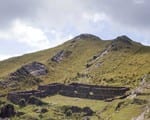SMU paleontologist Louis Jacobs quoted by Live Science for article on prehistoric plant-eating reptile
Science journalist Laura Geggel tapped the expertise of SMU Earth Sciences Professor Louis L. Jacobs for a recent article about a prehistoric plant-eating reptile.
A professor in Dedman College‘s Roy M. Huffington Department of Earth Sciences, Jacobs is a world-renowned vertebrate paleontologist.
He joined SMU’s faculty in 1983 and in 2012 was honored by the 7,200-member Science Teachers Association of Texas with their prestigious Skoog Cup for his significant contributions to advance quality science education.
Jacobs is president of SMU’s Institute for the Study of Earth and Man.
EXCERPT:
By Laura Geggel
Live Science
Despite its rows and rows of chisel- and needle-like teeth, a newly described prehistoric marine reptile wasn’t a fearsome predator but rather an herbivorous giant that acted like a lawnmower for the sea, a new study finds.The crocodile-size reptile lived about 242 million years ago, during the Middle Triassic period. Researchers discovered the first specimen in 2014 in southern China, but because it was poorly preserved, they reported that it had a beak like a flamingo’s.
Now, two newly discovered specimens show that the beast was far more bizarre: It sported a hammerhead-shaped snout that it likely used to graze on plants lining the ocean floor, the researchers said. It’s also the earliest herbivorous marine reptile on record by about 8 million years, they said. [The 12 Weirdest Animal Discoveries]
“I haven’t seen anything like it before,” said study co-researcher Olivier Rieppel, the Rowe family curator of evolutionary biology at The Field Museum of Natural History in Chicago.
Weird reptile
The reptile’s name — Atopodentatus unicus — hints at its weird anatomy. In Latin, the genus and species names translate to “unique strangely toothed,” the researchers said. The newly analyzed specimens show that the creature had a mouthful of chisel-shaped teeth — one row on the upper jaw and two rows on the lower jaw.“The remaining parts of the jaw [are filled with] densely packed needle-shaped teeth forming a mesh,” the researchers wrote in the study, published online today (May 6) in the journal Science Advances. This mesh likely helped A. unicus collect plant material, much like a baleen whale catches krill, said Louis Jacobs, a vertebrate paleontologist at Southern Methodist University in Texas who was not involved in the study.
The chisel-like teeth probably acted as a rake and trimmer, helping A. unicus scrape and dislodge plants from the seafloor, Jacobs said. Next, the reptile likely sucked in a mouthful of water, letting bits of plants get stuck in the mesh formed by its thin, needle-like teeth, he said.
“Then, they squish the water out of their mouth, and those little teeth along the sides of the jaw and on the roof of the mouth strain out all of the plant bits,” Jacobs told Live Science. “That’s an amazing way to feed. I’d like to do that myself.”
Follow SMU Research on Twitter, @smuresearch.
For more SMU research see www.smuresearch.com.
SMU is a nationally ranked private university in Dallas founded 100 years ago. Today, SMU enrolls nearly 11,000 students who benefit from the academic opportunities and international reach of seven degree-granting schools. For more information, www.smu.edu.
SMU has an uplink facility located on campus for live TV, radio, or online interviews. To speak with an SMU expert or book an SMU guest in the studio, call SMU News & Communications at 214-768-7650.



 NASA data leads to rare discovery: Earth’s moon wandered off axis billions of years ago
NASA data leads to rare discovery: Earth’s moon wandered off axis billions of years ago Good news! You’re likely burning more calories than you thought
Good news! You’re likely burning more calories than you thought New look at Pizarro’s conquest of Inca reveals foot soldiers were awed by empire’s grandeur
New look at Pizarro’s conquest of Inca reveals foot soldiers were awed by empire’s grandeur Charity, social justice and earth-friendly activism replace big houses, diamond rings and ostentatious living for status seekers
Charity, social justice and earth-friendly activism replace big houses, diamond rings and ostentatious living for status seekers National Center for Arts Research white paper counters findings of the Devos Institute Study on Culturally Specific Arts Organizations
National Center for Arts Research white paper counters findings of the Devos Institute Study on Culturally Specific Arts Organizations